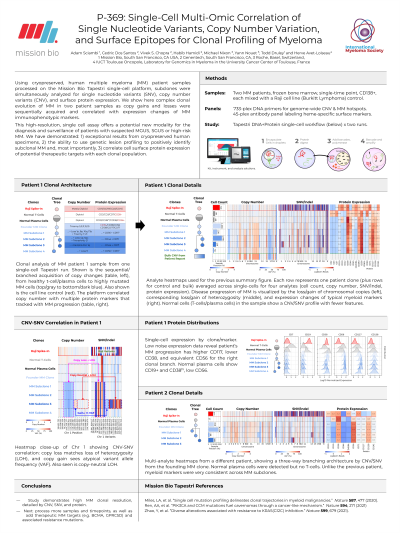Myeloma Genomics and cell signaling
Poster Session 3
P-369: SINGLE CELL MULTI-OMIC CORRELATION OF SINGLE NUCLEOTIDE VARIANTS, COPY NUMBER VARIATION AND SURFACE EPITOPES FOR CLONAL PROFILING OF MYELOMA
Friday, September 29, 2023
1:15 PM - 2:15 PM EEST


Adam Sciambi, PhD
Chief Technology Officer
Mission Bio, Inc
South San Francisco, California, United States
Introduction: Multiple myeloma (MM) is a cancer of plasma cells with approximately 200,000 new diagnoses each year and a 54% 5-year overall survival rate. As myeloma cells expand, clonal genetic differences lead to relapse due to acquired resistance in 100% of patients, mandating regular, long-term surveillance. Improvements in precision medicine for MM have come from monoclonal antibodies and antibody-drug conjugates that specifically target the offending cells. However, while existing diagnostic modalities offer exquisite sensitivity, they are limited in exploring subclonal genetic changes and putative antibody targets on refractory myeloma cells, leaving the clinician to use their best judgment on salvage therapy. Knowing the actual targets on the refractory disease would better facilitate precision medicine.
Methods: Using cryopreserved, human MM patient samples processed on the Mission Bio Tapestri platform, we were able to simultaneously quantify subclones by single-cell single nucleotide variants (SNV), copy number variants (CNV), and surface protein analysis. We show complex clonal evolution of MM in individual samples as copy gains and losses were sequentially acquired and correlated with expression changes of MM markers. These single time point samples were thawed from frozen bone marrow mononuclear cells previously enriched for CD38, stained with a 45-plex antibody-oligo cocktail to label common heme-specific surface markers for sequencing analysis, and processed with a 733-plex DNA primer panel that combined whole-genome CNV coverage with MM gene hotspots.
Results: Across the cases analyzed, complex branching phylogenetic trees were reconstructed with as many as five subclones and clear associated shifts in MM-marker expression. When averaged across subclones, each of the samples had CNV profiles that matched patient records, ranging from a single gene-level copy gain to arm-level gains and losses across the majority. The progression of protein expression within different samples could be mapped together on a single plot and correlated with generally higher MM-markers as subclonal genetic variants were acquired, though occasional branches saw reversal. The fraction of other cell phenotypes, such as T-cells and those with low viability, decreased within subclones as mutational burden grew. The drop in low viability implied improved clonal robustness (at least to handling) with disease progression.
Conclusions: This high-resolution, single cell assay offers a potential new modality for the diagnosis and surveillance of patients with suspected MGUS, SGUS or high-risk MM. We have demonstrated: 1) exceptional results from cryopreserved human specimens, 2) the ability to use genetic lesion profiling to positively identify subclonal MM and, most importantly, 3) correlate cell surface protein expression of potential therapeutic targets with each clonal and subclonal population.
Methods: Using cryopreserved, human MM patient samples processed on the Mission Bio Tapestri platform, we were able to simultaneously quantify subclones by single-cell single nucleotide variants (SNV), copy number variants (CNV), and surface protein analysis. We show complex clonal evolution of MM in individual samples as copy gains and losses were sequentially acquired and correlated with expression changes of MM markers. These single time point samples were thawed from frozen bone marrow mononuclear cells previously enriched for CD38, stained with a 45-plex antibody-oligo cocktail to label common heme-specific surface markers for sequencing analysis, and processed with a 733-plex DNA primer panel that combined whole-genome CNV coverage with MM gene hotspots.
Results: Across the cases analyzed, complex branching phylogenetic trees were reconstructed with as many as five subclones and clear associated shifts in MM-marker expression. When averaged across subclones, each of the samples had CNV profiles that matched patient records, ranging from a single gene-level copy gain to arm-level gains and losses across the majority. The progression of protein expression within different samples could be mapped together on a single plot and correlated with generally higher MM-markers as subclonal genetic variants were acquired, though occasional branches saw reversal. The fraction of other cell phenotypes, such as T-cells and those with low viability, decreased within subclones as mutational burden grew. The drop in low viability implied improved clonal robustness (at least to handling) with disease progression.
Conclusions: This high-resolution, single cell assay offers a potential new modality for the diagnosis and surveillance of patients with suspected MGUS, SGUS or high-risk MM. We have demonstrated: 1) exceptional results from cryopreserved human specimens, 2) the ability to use genetic lesion profiling to positively identify subclonal MM and, most importantly, 3) correlate cell surface protein expression of potential therapeutic targets with each clonal and subclonal population.
